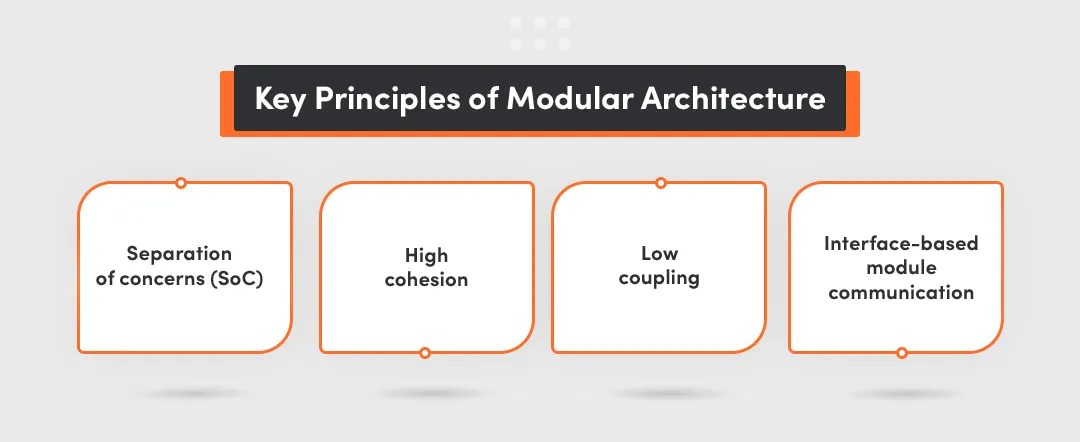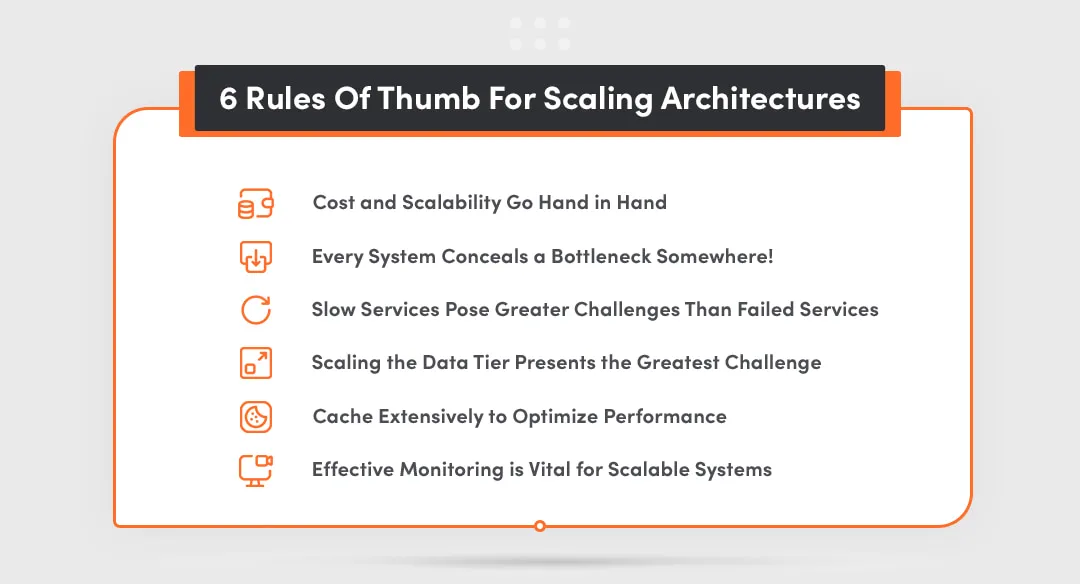As applications and systems evolve, the need to efficiently handle growth, changing requirements, and increasing user demands becomes paramount. Without an efficient architectural framework in place, software scalability can be a daunting and error-prone task, leading to issues such as bottlenecks, reduced system reliability, and skyrocketing maintenance costs.
Modular software architecture addresses these challenges by breaking down complex systems into smaller, manageable modules or components. These modules function independently while also collaborating seamlessly within the larger software system. This approach simplifies the addition of new features, enhancements, testing and the scaling of the software.
In this article, we will delve into the concept of modular software architecture, exploring its role in improving scalability and fostering enhanced development processes and future outcomes. By the end of this article, you'll have a comprehensive understanding of how modularity, in combination with other key variables, can significantly boost software development and enhance the outcomes of your projects.
What you will learn from this article:
- What is the difference between modular monolith, monolithic, and microservices?
- The key principles of modular architecture.
- 6 effective ways and possibilities to scale architectures.
- How does modular software architecture improve scalability?
- The use of modular monolithic architecture and the advantages it has over microservices.
- When to use specific scalable software architectures?
- What is modular monolithic architecture?
Key Principles of Modular Architecture
The success of modular architecture in software design hinges on a set of fundamental principles. Applying them allows developers to gain the benefits they promise. These key principles include the following:

- Separation of concerns (SoC)
Modular architecture divides a system into distinct modules, each handling a specific concern or functionality. This separation simplifies development, maintenance, and troubleshooting.
- High cohesion
Modules should contain closely related functions, promoting clarity and ease of understanding within each module system. High cohesion ensures that each module has a well-defined purpose.
- Low coupling
Modules should interact with minimal dependencies on other modules. Low coupling reduces the ripple effect of changes, enhancing system maintainability.
- Interface-based module communication
Interactions between modules should occur through stable, well-defined interfaces, not by directly delving into each other's internal implementation. This separation enhances flexibility, resilience, and maintainability.
What Is Modular Monolithic Architecture?
A modular monolithic architecture is an approach to application development that combines the benefits of modularity with a single, unified codebase and runtime environment. In this architectural style, the application maintains a single codebase for most of its components, much like a traditional monolithic application.
However, it also allows for modularization in specific areas, enabling certain independent components to be updated and maintained separately.
This approach aims to strike a balance between the simplicity of monolithic development and the flexibility of modular architecture. It is particularly well-suited for projects where stability and uniformity are required in some areas of the application, while other parts can benefit from the advantages of modularity and independent development.
Nevertheless, it's important to note that adopting a modular monolithic architecture may involve a trade-off between the ease of development and the level of flexibility. While it offers the benefit of maintaining a cohesive codebase, it can be more challenging to manage as developers must carefully define the boundaries between the integrated and modularized components.
Try our developers.
Free for 2 weeks.
No risk. Just results. Get a feel for our process, speed, and quality — work with our developers for a trial sprint and see why global companies choose Selleo.
What Are the Differences Between Microservices, Monolithic Architecture, and Modular Monolithic Architecture?

Microservices architecture is a modern software design approach that breaks down a complex application into small, independently deployable services. Each service focuses on a specific business functions and communicates with others through well-defined APIs.
This approach offers benefits such as scalability, flexibility, and the ability to use different technologies for each service. It also allows teams to work on individual services independently, which can speed up development.
However, managing numerous services can be complex, and inter-service communication needs to be well-implemented. Microservices (an example of distributed systems) are ideal for large, dynamic applications with changing requirements.
Monolithic architecture, on the other hand, is a traditional approach where an entire application is built as a single, tightly integrated unit. All layered architecture, including the user interface, business context, and data access layer, are part of a single codebase.
Monolithic applications are easier to develop and deploy since they don't require coordination between services. However, they can become unwieldy as they evolve, making maintenance and scalability challenging.
Even small updates may necessitate rebuilding and redeploying the entire application. Traditional monolith architecture is suitable for smaller projects or when simplicity and speed of development are paramount.
Modular monolithic architecture is a hybrid approach that combines elements of monolithic and modular architectures. It maintains a single, tightly integrated codebase for most of the application but allows for modularization in certain areas where independent components can be updated and maintained separately.
This approach strikes a balance between the simplicity of monolithic development and the flexibility of modularity. It is suitable for projects where stability is required in some areas, while others benefit from modular features.
However, it may involve a trade-off between ease of development and flexibility.
In summary, microservices offer flexibility and scalability but can introduce complexity in managing distributed systems. Monolithic architecture is straightforward but may become challenging to maintain as projects grow. Modular Monolithic Architecture combines aspects of both, providing some adaptability without the complexity of full microservices. It aims to balance simplicity and scalability to cater to specific project requirements.
6 Rules Of Thumb For Scaling Architectures
Scaling an architecture is a complex yet crucial task in software development. It involves accommodating a growing user base and increased demands while maintaining system performance. The following are six essential rules of thumb to keep in mind when scaling architectures:

Cost and Scalability Go Hand in Hand
One of the fundamental considerations when scaling an architecture is cost. Adding more resources, such as servers, bandwidth, or storage, can quickly become expensive. Therefore, it's essential to strike a balance between the desired level of scalability and the available budget.
Cost-effective scalability solutions, such as cloud services and containerization, can help mitigate financial concerns while ensuring your system can handle increased loads.
Every System Conceals a Bottleneck Somewhere!
In any architecture, there is always a bottleneck waiting to be discovered. Identifying this bottleneck is the first step in achieving effective scalability. It could be a particular component, database, or even a specific code segment.
Profiling and monitoring tools can help pinpoint performance bottlenecks, enabling you to address them before they become critical and affect the overall system's performance.
Slow Services Pose Greater Challenges Than Failed Services
Slow services can be more detrimental to your system's performance than outright service failures. When services are slow, they can impact the entire system, causing delays and timeouts for independent services. Users often prefer services that fail fast and gracefully, as this allows for quicker error recovery and ensures a better user experience.
Therefore, focus on optimizing performance to prevent slowdowns.
Scaling the Data Tier Presents the Greatest Challenge
Scaling the data tier, especially relational databases, can be one of the most challenging aspects of architecture. As data grows, managing databases and ensuring their performance becomes increasingly complex. Techniques like database sharding, replication, and caching can help address data tier scalability challenges.
However, it's important to design the data tier with scalability in mind from the start, as retrofitting can be difficult.
Cache Extensively to Optimize Performance
By storing frequently accessed data in memory, you can reduce the load on the data tier and improve response times. Caching can be applied at various levels, including application-level caches and content delivery networks (CDNs).
When implementing caching, consider cache eviction policies and expiration times to ensure data remains consistent and up to date.
Effective Monitoring is Vital for Scalable Systems
Effective monitoring provides real-time insights into system performance, resource utilization, and potential issues. By employing monitoring tools and setting up alerts, you can proactively identify and address problems before they impact users.
Continuous monitoring and analysis also help with capacity planning, allowing you to anticipate and prepare for future scaling needs.
Scalable Software Architecture - When To Use What?
Choosing the right architecture for your project or company is crucial, as it significantly impacts the development process, maintenance, and scalability. Let's explore when each of the three architectures is the most suitable choice - Monolithic, Modular Monolith, or Microservices.

Monolithic Architecture
Monolithic architecture is an excellent choice for projects that benefit from simplicity and a unified development process. It's particularly well-suited for companies or projects where a comprehensive, tightly integrated system is more efficient than separate modules. Examples include start-ups or small-scale applications, where the simplicity of a monolithic system can offer a better approach for a cohesive and well-defined set of functionalities. In a monolithic architecture, all the software components are interconnected and interdependent, making it easier to develop, test, and deploy. However, this architecture can present challenges in scaling and maintaining larger software solutions, as changes to one part of the system can affect the whole. This architecture is especially valuable when rapid development and deployment are more critical than modular scalability.
Modular Monolith
Modular Monolithic Architecture is ideal for greenfield implementations, such as a new peer-to-peer lending platform in the early stages of evolving into a comprehensive suite of financial services. In these early growth phases, having a cohesive codebase while enabling selective modularity allows for rapid development and adaptation to evolving requirements. This architectural style also fits well with systems of low to moderate scale, like a movie ticket booking platform serving several thousand users and handling a few thousand transactions a month, where the simplicity of a monolithic core can coexist with modular extensions for specific functionalities.
Additionally, modular monolithic architecture is ideal for non-complex business software platforms, such as notes and document syncing and management platforms for consumer apps. These applications benefit from the architecture's balance between simplicity and modularity, enabling efficient feature development and updates.
Microservices
Microservices architecture excels when an organization requires a swift adjustment to its functionality, enabling the deployment of these changes without disrupting the entire system. This capability to introduce new features without causing downtime is particularly valuable for many SaaS-based businesses. In such a dynamic environment, where the continuous operation of software products is paramount, Microservices offer the flexibility needed to keep services up and running without interruption. However, implementing and managing microservices can be complex, making it better suited for companies with a mature DevOps culture and the existing resources to invest in infrastructure and orchestration tools.
How Does Modular Software Architecture Improve Scalability?
Modular software architecture enhances scalability by breaking down the application into distinct, reusable modules. However, when it comes to improving scalability, modular monolith architecture deserves special attention.
In a modular monolith, the application maintains a single codebase, making it easier to manage and deploy. While it doesn't provide the same level of scalability as a full microservices architecture, it offers a middle-ground solution. Dividing the application into manageable modules within a single codebase, it allows for some level of modularity and flexibility without the added complexity of distributed architecture.
The key advantage of modular monolith architecture is its ability to adapt and expand to meet growing demands.
This approach facilitates the addition of new modules as needed, ensuring the modular system can evolve without the constraints of a monolithic architecture.
It strikes a balance between simplicity and scalability, making it a pragmatic choice for organizations looking to improve their systems' scalability while maintaining control and reducing operational overhead.
Why Does Modular Monolithic Architecture Kill Microservices?
One key advantage of modular monolithic architecture is its simplicity. In comparison to the complex infrastructure required for microservices, a modular monolith maintains a single codebase, making it easier to develop, test, and deploy. Managing a modular monolith is simpler than handling dozens of microservices. Modular monoliths come with basic underlying infrastructure and lower operational costs, making them more accessible for organizations with limited resources or smaller teams.
Additionally, modular monolith encapsulates business logic into modules, promoting high reusability. This means that different parts of the application can use the same modules, reducing redundancy and streamlining development.
For larger development teams, creating modular components within an application can significantly increase reusability. This leads to the establishment of a single source of truth, where modules can be reused across the organization. This, in turn, results in faster and more consistent development. Changes to one module have minimal or no impact on other modules, reducing the risk of unintended side effects.
Modular monolithic architecture offers a practical alternative to microservices by providing a balance between modularity and simplicity. It simplifies management, enhances the organization of dependencies, promotes reusability, and streamlines development, making it a favorable choice for many organizations and projects.
For more information about Microservices Killer: Modular Monolithic Architecture click here -> https://medium.com/design-microservices-architecture-with-patterns/microservices-killer-modular-monolithic-architecture-ac83814f6862
Summary
Modular Software Architecture streamlines development, making it easier to maintain, update, and expand applications, thereby improving overall operational efficiency. Additionally, this architecture allows for the organization of an application into distinct, independent modules, each responsible for specific functionalities, which is crucial for long-term maintainability and understanding of complex software systems.
While Modular Software Architecture is a robust choice for many scenarios, the decision to use Modular Monolithic Architecture over basic Monolith and Microservices depends on the specific needs of an organization or project.
For those seeking a balance between simplicity and scalability, Modular Monolithic Architecture offers a pragmatic solution. It is particularly useful for smaller teams, those with limited resources, and projects with growing complexity that don't want to commit to the intricacies of a full Microservices architecture.
As software architecture plays a pivotal role in a company's long-term success, it is crucial for every organization to evaluate its current architecture standpoint. By considering the advantages of modular software architecture and the specific benefits of modular monolith in certain scenarios, businesses can make informed decisions about their architectural choices.
Whether it's improving their current software architecture or considering changes for future projects, companies are encouraged to explore the opportunities that modular software architecture provides. By aligning architecture with their unique requirements, organizations can achieve scalability, maintainability, and efficiency that ultimately leads to greater success in the dynamic world of software development.




